The Industrial Microbiology Market is estimated to be valued at USD 17.9 billion in 2025 and is projected to reach USD 36.2 billion by 2035, registering a compound annual growth rate (CAGR) of 7.3% over the forecast period.
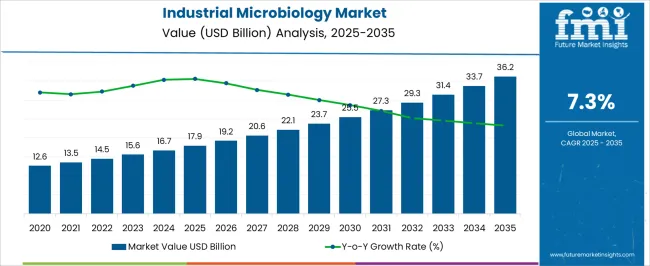
| Metric | Value |
|---|---|
| Industrial Microbiology Market Estimated Value in (2025 E) | USD 17.9 billion |
| Industrial Microbiology Market Forecast Value in (2035 F) | USD 36.2 billion |
| Forecast CAGR (2025 to 2035) | 7.3% |
The industrial microbiology market is experiencing sustained momentum owing to the rising demand for quality control, regulatory compliance, and product safety across multiple industries. Pharmaceuticals, biotechnology, food, and beverage sectors are increasingly prioritizing microbiological testing to ensure product integrity and compliance with stringent global standards.
Advances in automation, high throughput testing, and integration of digital systems are enabling faster, more accurate, and cost efficient microbiological analysis. Growing concerns around contamination risks, along with heightened regulatory oversight, have accelerated the adoption of advanced testing systems.
In addition, the expansion of biopharmaceutical production and personalized medicine has created strong opportunities for industrial microbiology applications. With industries emphasizing safety, efficacy, and sustainability, the outlook for this market remains positive, supported by continuous innovation and investments in advanced microbiological solutions.
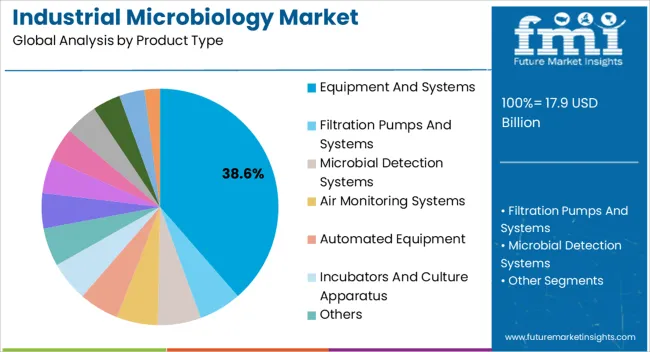
The equipment and systems segment is projected to hold 38.60% of total market revenue by 2025 within the product type category, making it the leading segment. This dominance is driven by the widespread integration of automated instruments, culture systems, and analytical devices that streamline workflows and reduce manual errors.
The demand for precision, reliability, and scalability in industrial testing has further reinforced reliance on advanced systems. Additionally, the capacity of these solutions to improve throughput and provide consistent data output has been recognized as essential across industries.
As a result, the equipment and systems segment continues to strengthen its position as the backbone of industrial microbiology operations.
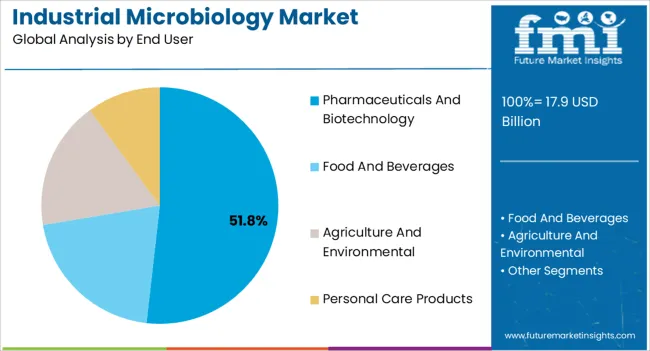
The pharmaceuticals and biotechnology segment is expected to account for 51.80% of total market revenue by 2025, emerging as the most prominent end user group. This growth is attributed to the increasing complexity of biologics, vaccines, and advanced therapies that demand stringent microbiological testing.
Regulatory requirements from international health authorities have also emphasized sterility, purity, and contamination control, driving significant adoption in this sector. With the rapid expansion of biopharmaceutical production facilities and investments in R&D, pharmaceutical and biotechnology companies are prioritizing reliable microbiology solutions to ensure product safety and regulatory compliance.
These factors have solidified the segment’s leadership in the overall market.
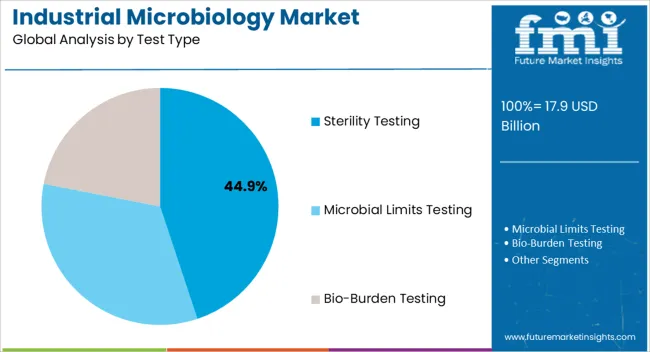
The sterility testing segment is projected to represent 44.90% of total market revenue by 2025 within the test type category, positioning it as the dominant segment. This prominence is the result of the critical importance of sterility verification in pharmaceuticals, medical devices, and biotechnology products.
Growing regulatory scrutiny on sterility assurance, along with the need to prevent product recalls, has reinforced its role in industrial microbiology. Continuous advancements in rapid sterility testing methods have reduced turnaround times while maintaining accuracy.
The necessity of meeting global standards for patient safety and therapeutic efficacy ensures that sterility testing remains the cornerstone of industrial microbiological practices.
The market for industrial microbiology secured a CAGR of 7.5% from 2020 to 2025 owing to the expansion of the pharmaceutical industry and increasing preference for automation, which are in turn bolstering the adoption of sterility testing within the pharmaceutical industry.
As per FMI, increasing adoption of testing procedures within the food & beverage industry is expected to bolster the market growth over the forecast period. Due to the growing demand for consumer products and the rise in the population worldwide, the adoption of sterility testing for product quality and safety testing is surging.
Emphasis on industrial safety and food & hygiene is likely to improve the demand over the coming years. Moreover, the rising application of industrial microbiology within agriculture, food & beverages, cosmetics, and pharmaceutical industries is also expected to open up a wide array of opportunities in the market.
The consumption of prescription antibiotics continues to increase the adoption of industrial microbiology among generic drug makers, despite the threat of rising anti-microbial drug resistance, especially across India and China.
The demand for industrial microbiology is set to expand at 7.6% CAGR during the assessment period from 2025 to 2035 based on the factors contributing to the market.
Focus on process automation of traditional industrial methods, aimed at reducing overall cost of production quite is likely to aid the expansion of the market further.
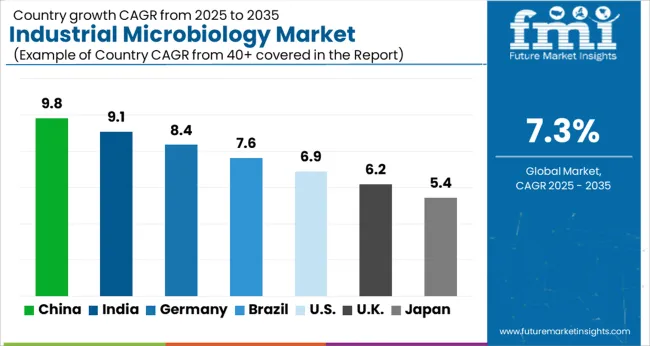
The United States of America is quite likely to lead North America’s industrial microbiology market over the forecast period, where North America held a value share of 27.8% in 2025.
The expansion of the pharmaceutical & biotechnology industry has paved the way for increased adoption of sterility testing across the country. Moreover, increased research & development activities in the field of the pharmaceutical industry along with drug discovery have propelled the industrial microbiology market growth.
Industrial microbiology applications across the United States of America are gaining popularity in the pharmaceutical excipients industry. The significantly growing food & beverage industry has also boosted the growth of industrial microbiology.
The increasing usage of microorganisms in the syrup formulations has improved the adoption of sterility as well as bio-burden testing. Further, the rising drug development and growing demand for pathogen testing in food products have significantly improved growth opportunities.
Stringent regulatory frameworks associated with anti-microbial food additives and favorable policies supporting the adoption of sterility testing have accelerated the demand for industrial microbiology, especially within the food & beverage industry. For instance,
In a 2024 report of the USA Food and Drug Administration for pharmaceutical microbiology, the government made it mandatory to go through a sterility and bio-burden test to examine the toxicity level of a drug or additive.
The United States of America market is expected to post substantial gains over the forecast period with a value share of 21.4% in 2025 on a global level, with the rapid adoption of sterility testing within the food & beverage industry,
The expansion of the biopharmaceutical industry and increasing adoption of sterility testing within the pharmaceutical & food and beverage industry have improved the demand for industrial microbiology.
As per Future Market Insights, China is expected to be the notable market, accounting for a significant share in the global industrial microbiology industry, and is likely to secure a 7.6% CAGR from 2025 to 2035.
With the growing population and rising disposable income, the demand for consumer products is expected to surge, which requires safety and quality testing of the products. Hence, increased adoption of sterility and bio-burden testing within the pharmaceutical industry can improve the demand.
Favorable government regulations and growing public concerns about the products’ safety are likely to accelerate the growth of China’s industrial microbiology market over the coming years.
Surging research and development activities within the pharmaceutical industry across India have improved the market demand for industrial microbiology, facilitating the country’s projected growth rate of 7.2% from 2025 to 2035.
The rising population and increasing demand for consumer products such as food additives and growing drug discovery push forward the adoption of sterility testing within the pharmaceutical and food & beverage industry.
The development and production of products rich in hyaluronic acid within dermatology applications have boosted revenue growth. Moreover, favorable regulatory policies and increasing investment from the government in research & development activities bolster the market growth during the forecast period.
Spiking healthcare spending and expansion of the pharmaceutical industry create growth opportunities. Furthermore, leading companies in the industrial microbiology market are shifting their production base with research & development activities across India for industrial microbiology applications due to additional benefits such as low labor, production, and land cost.
In terms of product type, the market is segmented into equipment & systems, reaction consumables, and others. As per FMI’s analysis, reaction consumables acquired a market share of 61.07% in 2025.
The soaring usage of reagents in the research and development activities on drug delivery is likely to improve the segment as well as market growth. Besides this, application in the biotechnological industry has improved the adoption of automated equipment and microbial detection systems.
Filtration pumps & systems, and air monitoring systems are extensively adopted, thereby improving the segment’s growth, with the rise in drug-related discovery in the pharmaceutical industry,
Sterility test type in industrial microbiology plays an important role in the food & beverage and pharmaceutical industries for quality check of products. Further, with extensive adoption of sterility tests in the pharmaceutical and food & beverages industry, the segment is expected to witness high demand over the forecast period.
Bio-burden, environment, and water tests are conducted on a large scale in the pharmaceutical industries. Moreover, industrial microbiology applications such as bio-burden tests are performed for aerobic or anaerobic organism testing, which is prompting growth within the segment. With the bio-pharmaceutical industry witnessing an upsurge, the adoption of sterility and bio-burden testing has gained prevalence.
By the FMI study, the sterility test type garnered a value share of 34.21% in 2025 on a global level.
Future Market Insights have sub-segmented the end user segment into pharmaceuticals & biotechnology, food & beverages, agriculture & environmental, and personal care products. As per the study, the pharmaceutical & biotechnology segment is anticipated to witness high growth during the forecast period and accounted for 51.7% market share in 2025.
The uptick in research & development activities within the pharmaceutical industry related to industrial microbiology has augmented over the years and is expected to propel in the future. As per the report by the Association of British Pharmaceutical Industry (ABPI), increased investment in research & development activities aimed at developing industrial microbiology products has increased the expenditure on healthcare.
As per ABPI, the pharmaceutical industry invested around USD 12.6 billion in 2020 and is expected to invest more in the upcoming years, accelerating market growth.
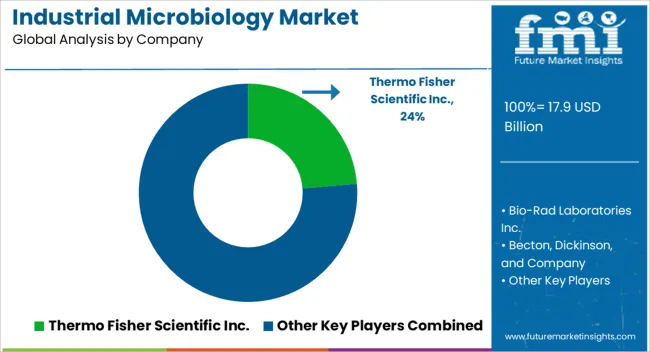
With a few top tier-1 players such as Thermo Fisher Scientific Inc., Merck KGaA, and BioMerieuxx dominating the market, the market is consolidated in nature, opines market study by FMI.
As per the study, the market for industrial microbiology is almost monopolistic with leading players expanding their existing wide product portfolio to maintain their lead in the industry.
These leading players have a strong presence and hold a significant market share in the industrial microbiology industry.
Their extensive product portfolios, technological advancements, and robust distribution networks contribute to their market dominance. However, the market also offers opportunities for small players to enter niche segments and cater to specific customer requirements, fostering competition and innovation within the industry.
Strategic mergers and acquisitions are sought-after among top healthcare companies. Stringent government regulations thwart the entry of new players, making the top players dominant in the industry. Leading players are relying on new product launches and other inorganic strategies to generate large revenues.
Developments in the Market:
The global industrial microbiology market is estimated to be valued at USD 17.9 billion in 2025.
The market size for the industrial microbiology market is projected to reach USD 36.2 billion by 2035.
The industrial microbiology market is expected to grow at a 7.3% CAGR between 2025 and 2035.
The key product types in industrial microbiology market are equipment and systems, filtration pumps and systems, microbial detection systems, air monitoring systems, automated equipment, incubators and culture apparatus, others, reaction consumables, media, simple media, complex media, defined media, specialty media, reagents and strains, others, laboratory supplies, bags and bottles, loop and needles, petri dishes, racks, seals, plates, and holders, filtration disc and membranes and others.
In terms of end user, pharmaceuticals and biotechnology segment to command 51.8% share in the industrial microbiology market in 2025.






Our Research Products

The "Full Research Suite" delivers actionable market intel, deep dives on markets or technologies, so clients act faster, cut risk, and unlock growth.

The Leaderboard benchmarks and ranks top vendors, classifying them as Established Leaders, Leading Challengers, or Disruptors & Challengers.

Locates where complements amplify value and substitutes erode it, forecasting net impact by horizon

We deliver granular, decision-grade intel: market sizing, 5-year forecasts, pricing, adoption, usage, revenue, and operational KPIs—plus competitor tracking, regulation, and value chains—across 60 countries broadly.

Spot the shifts before they hit your P&L. We track inflection points, adoption curves, pricing moves, and ecosystem plays to show where demand is heading, why it is changing, and what to do next across high-growth markets and disruptive tech

Real-time reads of user behavior. We track shifting priorities, perceptions of today’s and next-gen services, and provider experience, then pace how fast tech moves from trial to adoption, blending buyer, consumer, and channel inputs with social signals (#WhySwitch, #UX).

Partner with our analyst team to build a custom report designed around your business priorities. From analysing market trends to assessing competitors or crafting bespoke datasets, we tailor insights to your needs.
Supplier Intelligence
Discovery & Profiling
Capacity & Footprint
Performance & Risk
Compliance & Governance
Commercial Readiness
Who Supplies Whom
Scorecards & Shortlists
Playbooks & Docs
Category Intelligence
Definition & Scope
Demand & Use Cases
Cost Drivers
Market Structure
Supply Chain Map
Trade & Policy
Operating Norms
Deliverables
Buyer Intelligence
Account Basics
Spend & Scope
Procurement Model
Vendor Requirements
Terms & Policies
Entry Strategy
Pain Points & Triggers
Outputs
Pricing Analysis
Benchmarks
Trends
Should-Cost
Indexation
Landed Cost
Commercial Terms
Deliverables
Brand Analysis
Positioning & Value Prop
Share & Presence
Customer Evidence
Go-to-Market
Digital & Reputation
Compliance & Trust
KPIs & Gaps
Outputs
Full Research Suite comprises of:
Market outlook & trends analysis
Interviews & case studies
Strategic recommendations
Vendor profiles & capabilities analysis
5-year forecasts
8 regions and 60+ country-level data splits
Market segment data splits
12 months of continuous data updates
DELIVERED AS:
PDF EXCEL ONLINE
Industrial Grade Electrochemical CO Sensor Market Size and Share Forecast Outlook 2025 to 2035
Industrial Bench Scale Market Size and Share Forecast Outlook 2025 to 2035
Industrial Low Profile Floor Scale Market Size and Share Forecast Outlook 2025 to 2035
Industrial Sand Mill Market Size and Share Forecast Outlook 2025 to 2035
Industrial Control Network Modules Market Size and Share Forecast Outlook 2025 to 2035
Industrial Precision Oven Market Size and Share Forecast Outlook 2025 to 2035
Industrial Water Chiller for PCB Market Size and Share Forecast Outlook 2025 to 2035
Industrial & Commercial HVLS Fans Market Size and Share Forecast Outlook 2025 to 2035
Industrial Robot Controller Market Size and Share Forecast Outlook 2025 to 2035
Industrial Wired Routers Market Size and Share Forecast Outlook 2025 to 2035
Industrial Evaporative Condensers Market Size and Share Forecast Outlook 2025 to 2035
Industrial Energy Management System Market Size and Share Forecast Outlook 2025 to 2035
Industrial Insulation Market Size and Share Forecast Outlook 2025 to 2035
Industrial Safety Gloves Market Size and Share Forecast Outlook 2025 to 2035
Industrial Cleaner Market Size and Share Forecast Outlook 2025 to 2035
Industrial Dust Treatment System Market Size and Share Forecast Outlook 2025 to 2035
Industrial Vertical Washing Tower Market Size and Share Forecast Outlook 2025 to 2035
Industrial Pepper Market Size and Share Forecast Outlook 2025 to 2035
Industrial Electronics Packaging Market Forecast and Outlook 2025 to 2035
Industrial Absorbent Market Forecast and Outlook 2025 to 2035

Thank you!
You will receive an email from our Business Development Manager. Please be sure to check your SPAM/JUNK folder too.
Chat With
MaRIA